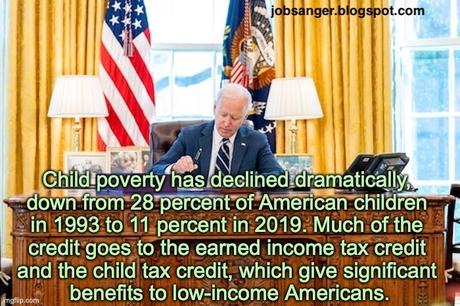
The Child Tax Credit (in combination with the Earned Income Credit) has significantly reduced child poverty in the United States. But to keep that reduction intact, the Child Tax Credit, which expired at the end of 2021, needs to be restored. Unfortunately, all Republicans and Democratic senator Manchin, oppose it. We need a blue wave in this election to keep our gains on child poverty.
Here's part of how Paul Waldman and Greg Sargent describe this in The Washington Post:
As a new report from the Center on Budget and Policy Priorities shows, we did something extraordinary during the worst parts of the coronavirus pandemic: In the midst of a crisis that affected every part of our society and could have been economically calamitous, we drove poverty down. As economically painful as the crisis was, the aggressive public spending passed across the Trump and Biden presidencies dramatically mitigated the hardship Americans suffered.
Using just-released census figures, the group reports the results of the pandemic stimulus measures in 2021. In particular, the study looked at the expansion of the child tax credit, which was altered to give monthly payments to eligible families, including those with incomes too low to have income tax liability:
The expanded Child Tax Credit alone kept 5.3 million people above the annual poverty line and helped drive a stunning reduction in child poverty to a record low. Poverty overall also reached a record low and the uninsured rate dropped substantially, with Medicaid and Affordable Care Act (ACA) marketplace coverage reaching or nearing record highs.
The effect on minority groups was particularly dramatic: “In 2018 nearly 1 in 4 Black children lived in families with incomes below the poverty line. In 2021, fewer than 1 in 10 did.”
It’s important to remember that we define “poverty” as a line one can be over or under. The fact that a family has a bit more income than where that line is placed doesn’t mean they don’t struggle to make ends meet.
But government assistance can mean the difference between a family having enough to eat, being able to pay the rent and utilities, or becoming homeless. And it’s clear that antipoverty spending has had a tremendous impact.
This week the New York Times reported comprehensive data showing that over the past three decades, child poverty has declined dramatically, down from 28 percent of American children in 1993 to 11 percent in 2019. Much of the credit goes to the earned income tax credit and the child tax credit, which give significant benefits to low-income Americans.
Now, here’s the bad news: Sadly, the expanded CTC expired at the end of 2021. Almost all Democrats in Congress wanted to extend the expansion, but Sen. Joe Manchin III (D-W.Va.) refused; he reportedly told colleagues he worried that parents would use the money to buy drugs. Without that extra income, millions of children fell back into poverty in 2022.

